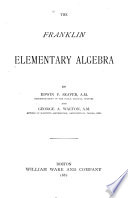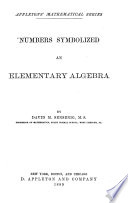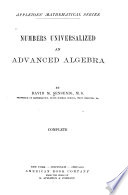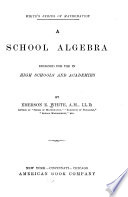 | Edward Olney - Algebra - 1882 - 358 pages
...expansion is unity / of the second, the exponent of the required power ; and that of any other term may be found by multiplying the coefficient of the preceding term by the exponent of the first letter in that term, and dividing the product by the exponent of the second letter + 1. 190.... | |
 | Edwin Pliny Seaver, George Augustus Walton - Algebra - 1881 - 304 pages
...That the co-efficient of the first term is 1 ; and the co-efficient of any term after the first may be found by multiplying the co-efficient of the preceding term by the exponent of the leading quantity in that term, and dividing the product by the number of terms that precede the... | |
 | Charles Davies - Algebra - 1889 - 330 pages
...equal to tlie exponent of the power. 2. LAW OF COEFFICIENTS. The coefficient of the first term is 1 y the coefficient of any succeeding term is found by...coefficient of the preceding term by the exponent of the leading letter in that term, and dividing the product by the number of terms preceding the required... | |
 | David Martin Sensenig - Algebra - 1889 - 388 pages
...is one ; of the second term, the exponent of the binomial ; and that of each succeeding term may be found by multiplying the coefficient of the preceding term by the exponent of the leading letter in that term, and dividing the product by the number of that term from the beginning.... | |
 | David Martin Sensenig - Algebra - 1890 - 556 pages
...is unity ; of the second term, the exponent of the binomial; and that of each succeeding term may be found by multiplying the coefficient of the preceding term by the exponent of the leading letter in that term, and dividing the product by the number of that term. Note. — The... | |
 | Asa Hollister Craig - Examinations - 1897 - 538 pages
...power of the coefficient ofthe leading term in the root; and that the coefficient of any term may be found by multiplying the coefficient of the preceding term by the exponent of the leading quantity m that term and by the coefficient ofthe following quantity in the root, and dividing... | |
 | Emerson Elbridge White - Algebra - 1896 - 418 pages
...exponent of the power of the binomial ; and generally the coefficient of any term is the product of the coefficient of the preceding term by the exponent of a in that term, divided by the number of that term. For example, in the fourth power of a + b, the coefficient of the... | |
 | Fletcher Durell, Edward Rutledge Robbins - Algebra - 1897 - 482 pages
...of the second term, it is the index of the required power. In each succeeding term the coefficient is found by multiplying the coefficient of the preceding term by the exponent of ж in that term, and dividing by the exponent of a, inci'eased by 1. IV. Signs of Terms. If the binomial... | |
 | William James Milne - Algebra - 1901 - 476 pages
...the second term is the same as the index of the required power. 5. The coefficient of any term may be found by multiplying the coefficient of the preceding term by the exponent of the first term of the binomial found in that term, and then dividing the result by the number of the... | |
 | George Egbert Fisher, Isaac Joachim Schwatt - Algebra - 1901 - 646 pages
...coefficient of any term after the second is obtained, except for sign, by multipli/iiiy the roc//iY/V/ii of the preceding term by the exponent of a in that term, and diridiny the product b<j и number greater by 1 than the exponent of b in that term. Eg, the coefficient... | |
| |